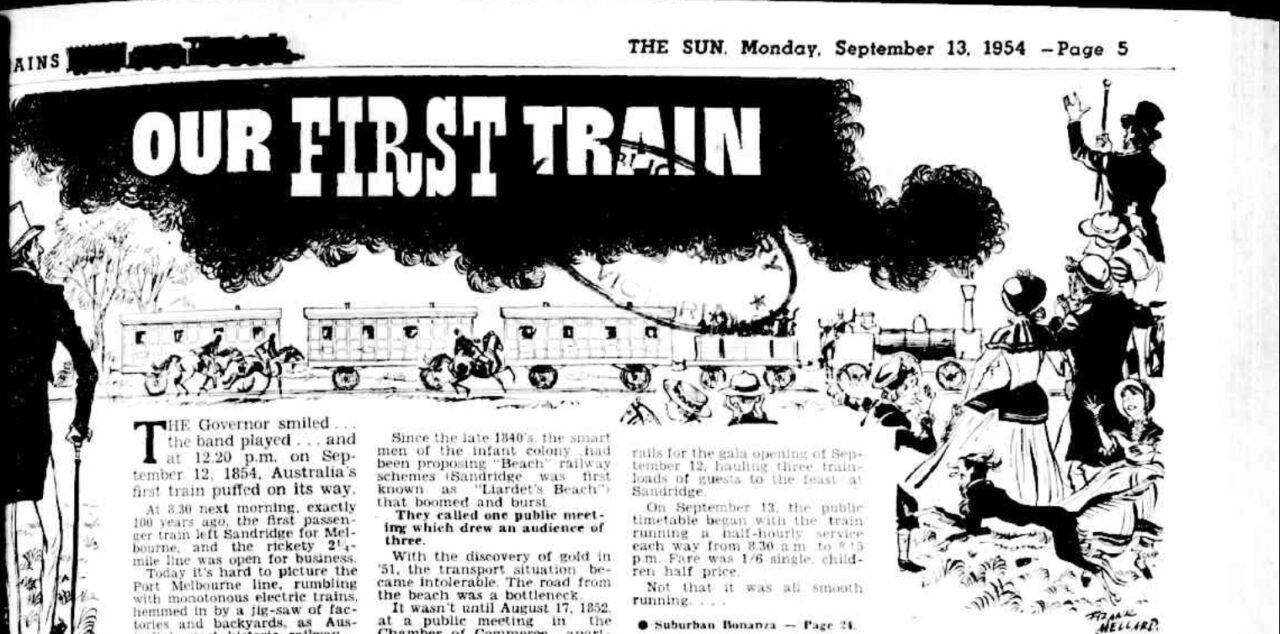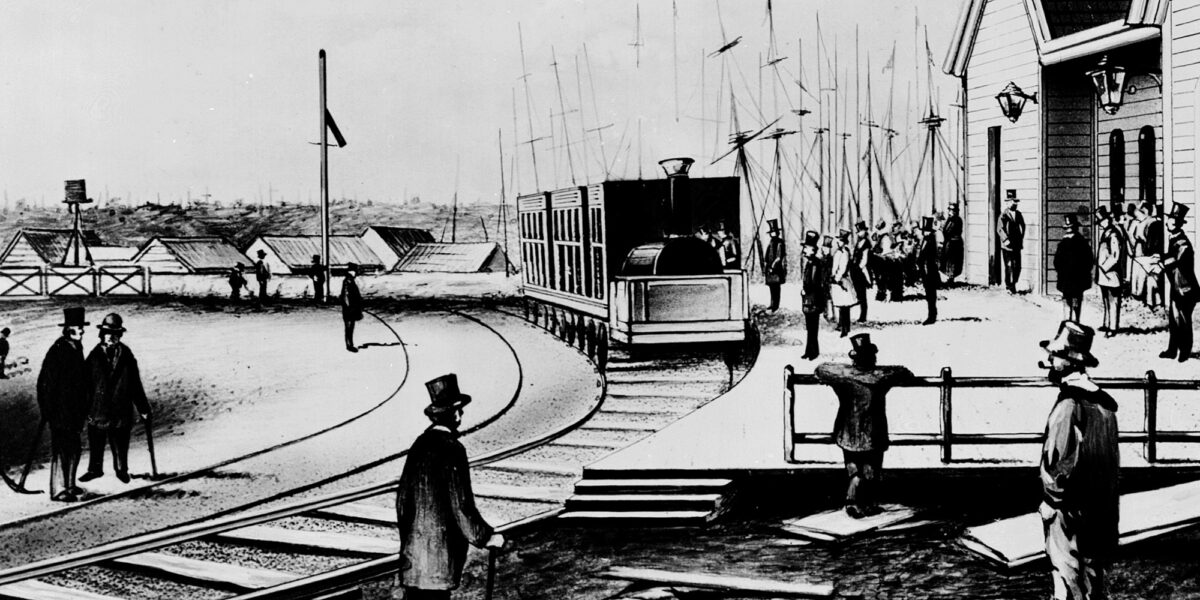Thursday marked Flinders Street station’s 170th birthday, which also means it was 170 years since Australia’s first steam passenger train first opened, from Sandridge (now Port Melbourne) to Flinders Street.
(As this article notes, it wasn’t Australia’s passenger train; a horse-drawn service opened earlier in 1854 near Adelaide.)
After a day of celebration on 12th September 1854, the regular public service started the next day.
One detail often forgotten in historic accounts of new railways is how often the trains ran.
So how frequent was Melbourne’s first train service? Via Trove, I found this:
On September 13, the public timetable began with the train running a half-hourly service each way from 8:30am to 8:15pm. Fare was 1/6 single, children half price.

The trip took 10 minutes, with initially no intermediate stations. Apparently there was only one engine for the first few months, so a half-hourly service was about as good as they could manage – though by the 1880s when railways in Victoria were booming, it was still half-hourly.
By the 1930s the Port Melbourne line was running every 12 minutes at most times, before dropping back to mostly every 20 minutes by 1980. The railway was converted to light rail (tram) in 1987.
| Year | 1854 (steam) | 1880 (steam) | 1939 (electric) | 1980 (electric) | 2024 (tram) |
|---|---|---|---|---|---|
| Year | 1854 | 1880 | 1939 | 1980 | 2024 |
| Peak frequency mins | 30 | 30 | 12 | 15 | 6 |
| Daytime frequency mins | 30 | 30 | 12 | 20 | 10 |
| Evening frequency mins | None | 60 | 12 | 20 | 20 |
| Last service weeknights | 20:15 | 23:18 | 00:00 | 23:51 | 00:03 |
| Running time mins | 10 | 7 | 7 | 7 | 11-18 |
| Intermediate stops | 0 | 1 | 3 | 3 | 7-10* |
Some frequencies reduced on Sundays, eg only every 40 minutes in 1980
*7 intermediate stops from the Port Melbourne terminus to Southern Cross Station, or 10 to Town Hall.
The tram is a bit slower than the train was, but mostly more frequent… with the exception of evenings.
I don’t expect the government to upgrade tram frequencies purely due to historic precedent. But you’d hope they’re looking at how travel patterns have changed.
These days, fewer people are going into CBD offices five days a week, but people are still travelling, particularly on weekends and evenings… to the extent that roads are often congested and PT is often crowded at these times due to lack of services.
Route 109 isn’t alone here, it’s a network-wide issue. But are decision makers paying attention?
Lead picture: Flinders Street Station in 1854 – looking west – drawing by S T Gill, via PROV


7 replies on “170 years since Melbourne’s first train”
Slightly embarrassing that it takes longer to get from the city to Port Melbourne (on dedicated tracks) than it did 170 years ago – and the former was with steam.
@Roger, yep – the problem is it’s not all dedicated tracks now. You can get to the Clarendon St stop in 7 minutes. After that the tram is waiting for traffic lights… and unlike other cities, Melbourne is incapable of providing tram priority.
An example from Canberra: https://www.youtube.com/watch?v=5JKJrABYpRg
I found the cost rather interesting.
“Fare was 1/6 single, children half price.”
Does single mean one way?
I couldn’t find any Australian historical currency converter going back to the 1850s, but the RBA has one that goes back to 1901, and converts the amount you enter to its equivalent value in any year up to 2023.
So I plugged in 1/6 for 1901. That converts to $13.64 in 2023. So we can conclude that in 1854, the fare cost at least $13.64 in today’s money. Just how much more, we don’t know.
Even $13.64 is rather a lot, especially for a destination close enough that most people could walk it, and especially if single means one way only and you need to pay an additional fare to return. A seaside outing with the whole family would chew up rather a lot of the average weekly wage.
@Karen, it does sound expensive, but it was a novelty back in 1854. I can contribute another datapoint. I have a Melbourne-Prahran/Windsor timetable from December 1948. A first class single fare from Windsor to Melbourne cost 4d, a return fare was 7½d. Second class single fare was 3d, return fare 6d.
Using the RBA converter at https://www.rba.gov.au/calculator/annualPreDecimal.html
that 4d fare is equivalent to $1.22 in 2023 money, as compared to $5.30 for today’s Zone 1, 2 hour ticket.
The periodical tickets were no bargains. The weekly periodical (1st class) was 4/4 (4 shillings and 4 pence), a fraction less than seven times the return fare.
The monthly fare was 17/3 which is 27.6 times the return fare. But the monthly fare is equivalent to $63.03 in 2023 money – roughly six days of Myki zone 1 tickets.
Interesting point on the fares! (Yes, a single fare is one way)
The 1880 timetable (page 67) says the fare that year was 3 pence one way second class, which using the RBA calculator 1901-2023 comes out at $2.27
First class it was 4 pence. Return fare was 1.5 times the single fare.
Regarding weekly fares, note that the working week used to be Monday to Friday plus Saturday morning. Not sure when that ended – possibly also around 1948 when the 40 hour week was introduced.
Still, not a bargain. Maybe they assumed most people would travel for non-work purposes as well as for commuting?
Not that much difference in speed once you count the several 15 km/h speed restrictions over points, compulsory stops at facing points and at Port Junction, and light rail vehicles on their own segregated track all the way from Port Melbourne to North Richmond being forced to stop every hundred metres for cars at traffic lights instead of having Skyrail version 0.1 alpha starting from the up end of Montague, no flat crossing with the St Kilda line at Port Junction, and running express all the way to Flinders Street Station due to not having any intermediate stops.
Re the fare from Windsor in 1948. At that time stations at which trams competed for traffic had special low fares (otherwise everyone would catch the fast electric trams). Nowdays, of course, there’s no competition.
This policy caused much wailing and nashing of teeth by localities that were not so blessed with tramway competition. So much so that when the MMTB came up with their grand expansion plan in the mid ’20s, it was widely supported by middle ring councils specifically because of the exptectation of lower fares on both rail and tram.